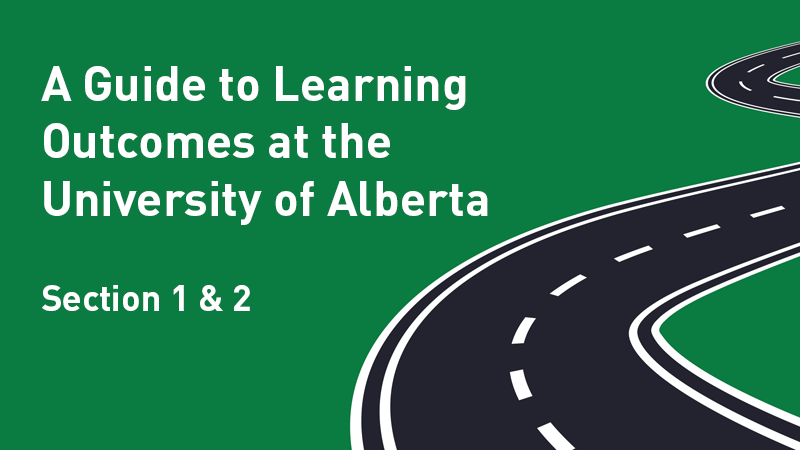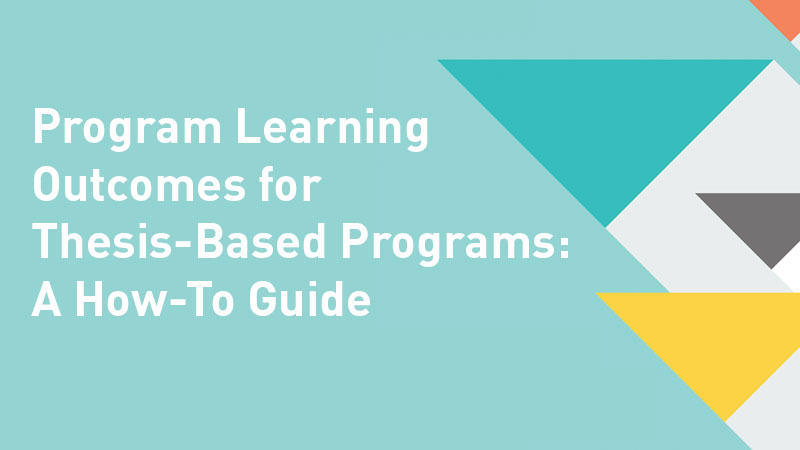Learning Outcomes
Learning outcomes are direct statements that describe the essential knowledge and abilities students should possess, and the depth of learning expected upon completion of a course or program. Students benefit from clearly articulated and assessed course-level learning outcomes, which are also the foundation for an effectively aligned and integrated curriculum (Joosten & Cusatis, 2019, Vai & Sosulski, 2015; Biggs, 2014; Fink, 2013).

What Are Learning Outcomes?
Sections 1 & 2 of this guide are designed to assist instructors and programs in writing effective learning outcomes. For each section, you can (a) read a scenario and learn from others' experiences; and (b) get answers to key questions, and suggestions to consider for your own context and needs. Learn more.
A complete version of the Learning Outcomes guide is also available here.

Program Learning Outcomes for Thesis-Based Programs: A How-To Guide
Program Learning Outcomes for Thesis-Based Programs: A How-To Guide by https://www.ualberta.ca/graduate-studies is licensed under a Creative Commons Attribution-NonCommercial-ShareAlike 4.0 International License.
Permanent link: https://doi.org/10.7939/r3-8vd4-t419
How to Clearly Articulate Learning Outcomes?
This video will give you information about how learning outcomes, assessment and bloom's taxonomy work together.
Effective Alignment and Integration of Learning Outcomes, Instruction, and Assessments
Learning outcomes are most effective when they are used in conjunction with planning your teaching inputs and your assessments. Aligned outcomes foster deep learning approaches (Wang et al., 2013), improved student satisfaction and evaluations of teaching (Larkin & Richardson, 2011), and increased student engagement with online resources (Reaburn et al., 2009)
Constructive alignment (CA; Biggs, 2014) is an outcomes-based approach to teaching in which the learning outcomes that students are intended to achieve are defined before teaching takes place. Teaching and assessment methods are then designed to best achieve those outcomes and to assess the standard at which they have been achieved (2014, p. 5).
'Alignment,' refers to what the teacher does, to setting up a learning environment that supports the learning activities appropriate to achieving the desired learning outcomes (Biggs, 2003). According to Biggs, the key aspect of alignment is that the components in the teaching system, especially the teaching methods used and the assessment tasks, are aligned with the learning activities assumed in the intended outcomes.
There are four major steps in an aligned system (Biggs, 2003):
- Defining the intended learning outcomes (ILOs);
- Choosing teaching/learning activities likely to lead to the ILOs;
- Assessing students' actual learning outcomes, to see how well they match what was intended;
- Arriving at a final grade.
Best Practices Informing the Writing of Learning Outcomes
We suggest checking that course learning outcomes meet the following criteria. Your learning outcome should:
- clearly match up to the assessments (e.g. assignment, quiz, exam);
- be found easily in eClass, the syllabus, in presentations, etc.;
- be about what my students are learning, not what they are doing;
- start with assessable verbs and avoid 'understand', 'know', appreciate', etc (watch from 02:42 - 05:20 of the Learning Outcomes, Assessment & Bloom's Taxonomy video);
- be achievable;
- be assessable—and you should know how you can assess it effectively;
- be clear and easily understood;
- only have one verb;
Learning outcomes are most effective when they are used in conjunction with planning your teaching inputs and your assessments.
Scholars such as Lawlor and Hornyak (2012) and Bowman et al. (2015) have also suggested making sure your learning outcomes are SMART (Specific, Measurable, Attainable, Relevant, Timely).
 |
SpecificThe more specific you make your learning outcome, the more effective it will be at identifying not only what is to be learned but also what is to be assessed. Poor example: By the end of the course, you will understand what micro-organisms can be used for. Good example: By the end of the course you will be able to describe how micro-organisms are used as model systems to study basic biology, genetics, metabolism and ecology. |
|
 |
MeasurableHow will the success of this learning outcome be measured? Will it be formatively or summatively assessed? Will it be self-assessed? Peer-assessed? Instructor-assessed? Are you using a verb which is measurable (e.g., list, define, extrapolate) and avoiding those which aren't (e.g., appreciate, understand, know, etc.). For more information about which verbs to avoid, watch 02:42 - 05:20 of the Learning Outcomes, Assessment & Bloom's Taxonomy video. |
|
 |
AchievableCan this outcome be achieved within the time frame and with the resources available? Is it too easy? Too difficult? |
|
 |
RelevantDoes the learning outcome make sense in the wider context of the course/programme? Does this outcome align with the instructional method (implementation) and with how it is being assessed? |
|
 |
TimelyWhen will this outcome be achieved? Do other learning outcomes need to be achieved first before this one can be accomplished successfully? If so, is this learning outcome in the correct place in the sequence of learning? |
Works Referenced on This Page
Biggs, J. (2014). Constructive alignment in university teaching. HERDSA Review of Higher Education, 1, 5-22. https://www.herdsa.org.au/herdsa-review-higher-education-vol-1/5-22
Fink, L. D. (2013). Creating significant learning experiences: an integrated approach to designing college courses. Jossey-Bass. https://ebookcentral.proquest.com/lib/ualberta/ detail.action?docID=1394307
Joosten, T., & Cusatis, R. (2019). A Cross-Institutional Study of Instructional Characteristics and Student Outcomes: Are Quality Indicators of Online Courses Able to Predict Student Success?. Online Learning, 23(4). http://dx.doi.org/10.24059/olj.v23i4.1432
Larkin, H. & Richardson, B. (2013). Creating high challenge/high support academic environments through constructive alignment: student outcomes, Teaching in Higher Education, 18(2), 192-204. https://doi.org/10.1080/13562517.2012.696541
Lawlor, K. B., & Hornyak, M. J. (2012). SMART Goals: How the application of SMART goals can contribute to achievement of student learning outcomes. Developments in Business Simulation and Experiential Learning, 39, 259-267. https://absel-ojs-ttu.tdl.org/absel/index.php/absel/ article/view/90/0
Reaburn, P., Muldoon, N., & Bookallil, C. (2009). Blended spaces, work based learning and constructive alignment: Impacts on student engagement. Same places, different spaces. Proceedings ASCILITE Auckland 2009, 820-831. http://www.ascilite.org.au/conferences/auckland09/procs/raeburn.pdf
Vai, M., & Sosulski, K. (2015). Essentials of online course design: A standards-based guide. New York: Routledge. https://doi.org/10.4324/9781315770901
Wang, X., Su, Y., Cheung, S., Wong, E., & Kwong, T. (2013). An exploration of Biggs’ constructive alignment in course design and its impact on students’ learning approaches. Assessment & Evaluation in Higher Education, 38(4), 477-491. https://doi.org/10.1080/02602938.2012.658018
Further Resources
- "Graduate Learning Outcomes" video presentation, Brenda Brouwer, Queen's University.
- "Why Should a Research-Intensive University Care About Learning Outcomes?" video presentation, Dr. Harvey Weingarten, President Emeritus of the University of Calgary.